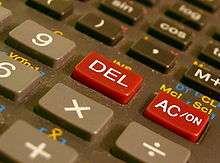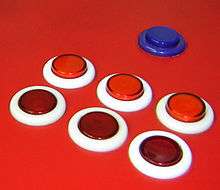Push-button



A push-button (also spelled pushbutton) or simply button is a simple switch mechanism for controlling some aspect of a machine or a process. Buttons are typically made out of hard material, usually plastic or metal.[1] The surface is usually flat or shaped to accommodate the human finger or hand, so as to be easily depressed or pushed. Buttons are most often biased switches, though even many un-biased buttons (due to their physical nature) require a spring to return to their un-pushed state. Different people use different terms for the "pushing" of the button, such as press, depress, mash, hit, and punch.
Uses
The "push-button" has been utilized in calculators, push-button telephones, kitchen appliances, and various other mechanical and electronic devices, home and commercial. In industrial and commercial applications, push buttons can be connected together by a mechanical linkage so that the act of pushing one button causes the other button to be released. In this way, a stop button can "force" a start button to be released. This method of linkage is used in simple manual operations in which the machine or process have no electrical circuits for control.
Pushbuttons are often color-coded to associate them with their function so that the operator will not push the wrong button in error. Commonly used colors are red for stopping the machine or process and green for starting the machine or process.
Red pushbuttons can also have large heads (called mushroom heads) for easy operation and to facilitate the stopping of a machine. These pushbuttons are called emergency stop buttons and are mandated by the electrical code in many jurisdictions for increased safety. This large mushroom shape can also be found in buttons for use with operators who need to wear gloves for their work and could not actuate a regular flush-mounted push button. As an aid for operators and users in industrial or commercial applications, a pilot light is commonly added to draw the attention of the user and to provide feedback if the button is pushed. Typically this light is included into the center of the pushbutton and a lens replaces the pushbutton hard center disk. The source of the energy to illuminate the light is not directly tied to the contacts on the back of the pushbutton but to the action the pushbutton controls. In this way a start button when pushed will cause the process or machine operation to be started and a secondary contact designed into the operation or process will close to turn on the pilot light and signify the action of pushing the button caused the resultant process or action to start.
In popular culture, the phrase "the button" (sometimes capitalized) refers to a (usually fictional) button that a military or government leader could press to launch nuclear weapons.
See also
References
- ↑ "Push buttons and much more". thebuilderssupply.com. Retrieved 11 April 2013.
External links
- Spring Return Button by Sándor Kabai, The Wolfram Demonstrations Project.